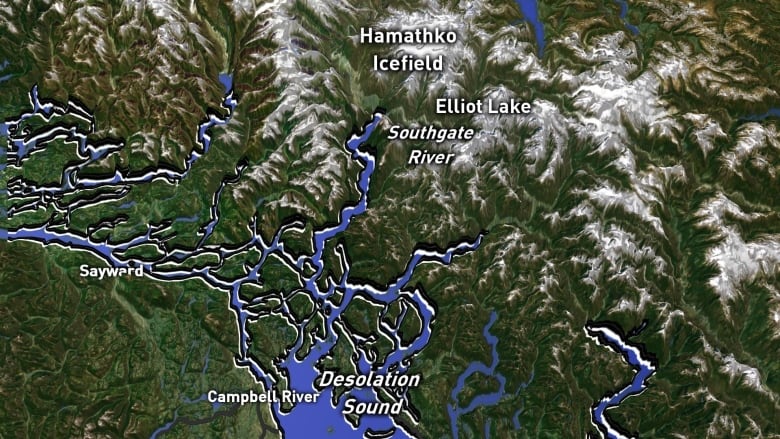Landslide triggers massive debris cascade in remote part of B.C. coast
Force of event in November equivalent to a magnitude 4.9 earthquake, scientists say

A massive landslide on the B.C. coast about 220 kilometres northwest of Vancouver in November propelled approximately 7.7 million cubic metres of debris into an ocean inlet, reshaping a swath of coastal landscape.
Scientists say the force of the event was equivalent to a magnitude 4.9 earthquake — and was about one-sixth the size of one of Canada's biggest landslides in 1965.
The so-called Hope Slide near Hope, B.C., in January 1965 was one of the largest in Canadian history, sending 47 million cubic metres of rock, mud and debris across Highway 3.
But last month's slide into Bute Inlet went almost unnoticed for weeks, as it was in such a remote area.
Scientists say the initial slide happened on the mainland about 110 kilometres northeast of the closest city, Campbell River on Vancouver Island, when a steep slope let go and sent debris into a swollen glacial lake.

Geologists and seismologists believe that initial slide caused what they refer to as an "outburst flood," that happened when the lake overflowed in a sudden wave down the mountain around 6 a.m. PT on Nov. 28.
'Cascade of hazards'
"This is the kind of thing that I get excited about," said Daniel Shugar, an associate professor in the department of geoscience at the University of Calgary.
"It's quite an interesting hazards cascade or sort of domino series of events. One landslide triggered a displacement wave — like a tsunami in the lake — which cut down through the moraine [a debris accumulation] that was damming that lake to cause this outburst flood and then this turbidity current in the ocean."
Shugar suspects heavy rain caused the initial slide on the slope that had shown instability before. The sudden burst of water from the lake created a knock-on effect propelling millions of cubic metres of mud and debris and scouring out Elliot Creek into more of a canyon.
"This slurry of material, almost like wet concrete, carrying boulders would have been washing down Elliot Creek and then the Southgate River and would have uprooted trees and deposited them into Bute Inlet," said Shugar.
Watch | Footage from helicopter pilot's camera as he discovers the magnitude of the debris field:
It has been a rainy fall, with Rivers Inlet residents forced out for fear of landslides in late October. But, other than the odd lodge, there are rarely people near the area where this slide was triggered, especially in winter.
Curious helicopter pilot discovers size of landslide
On Dec. 10, with logs and trees floating into Bute Inlet, a helicopter pilot decided to fly over the remote area near the Southgate River — about a 15-minute flight from Campbell River — looking for the source of the destruction, at first following the Southgate River, then the creek.
Bastian Fleury of 49 North Helicopters has flown for a decade, so he's seen a few slides. But nothing like this.
"It was just a weird sight. I've seen landslides but that's a big, big one. We knew something big happened," he said.
Fleury could not fly far enough to find the source, because the weather was hazardous, and visibility higher up wasn't great.
But he suspected that it was somehow related to the glacial lakes fed by the Homathko Icefield, one of the largest in the southern half of the Coast Mountains.
In Fleury's footage, as the helicopter flies along the former creek bed, it's clear that whatever force came down the mountain was powerful. The shallow creek bed has been transformed into a steep-sloped canyon. In other still photos along the river, odd islands of spindly trees are precariously perched, as a mud river continues to flow by.
"It's really crazy," said Fleury, who is looking forward to flying up farther to see the initial site where the slope collapsed, when the weather co-operates.



